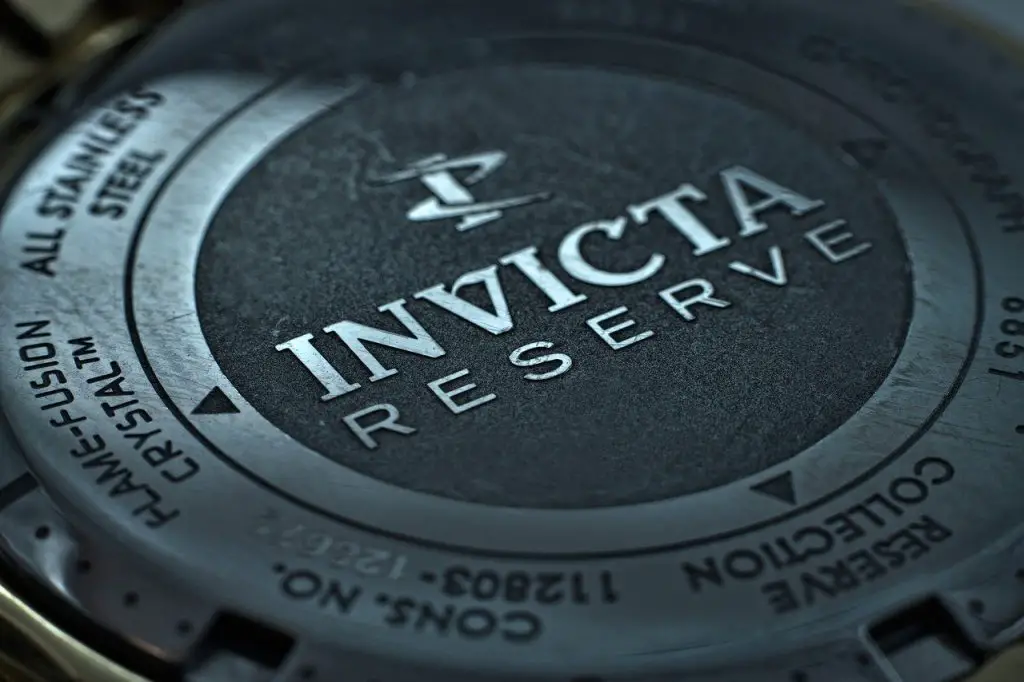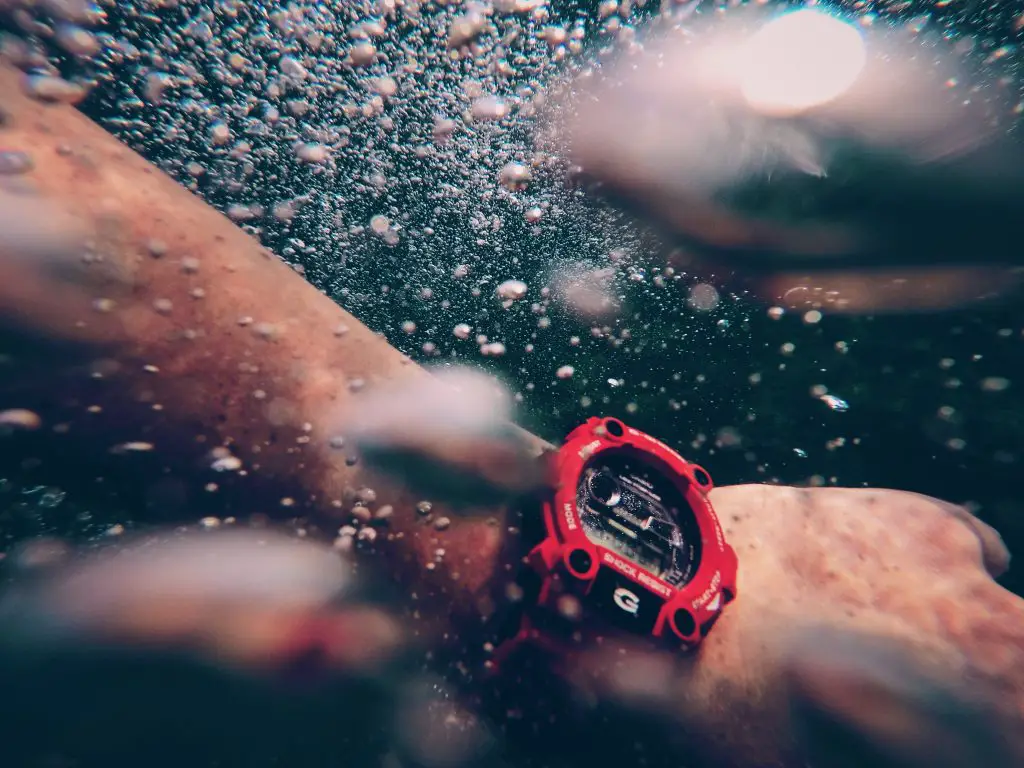Most watches nowadays are known to be waterproof, but this isn’t always the case. This begs the question; are Invicta watches waterproof?
Invicta watches are waterproof. Invicta watches have a tightly sealed crown, case back, and crystal (face of the watch) that will allow no water inside the watch. If you crack either of these components, your watch will no longer be waterproof.
While an Invicta watch is generally waterproof, there is some more nuance to this. This article explains what you can and can’t do with your Invicta watch near water!

Table of Contents
Are Invicta Watches Waterproof
Invicta is a watch brand that, for some reason, always seems to be on sale. With this in mind, some people might consider Invicta a cheaper, lower-quality brand. This, however, is not the case.
Invicta actually makes good-quality watches, especially when compared to their price. Of course, don’t expect anything ultra-luxurious, but an Invicta watch is affordable, looks great, and is of decent enough quality.
And that’s very important to know. While being an affordable brand, Invicta does make sure that its watches are up to standard. And that standard includes a level of water resistance.
Everything from the crown to the back of the case, to the crystal face of the watch, is placed carefully, ensuring that it’s sealed tightly. This is what makes a watch waterproof, after all.
But does this go for every Invicta watch out there? In a general sense, yes, every Invicta watch is waterproof. However, some watches can go much deeper than others.
The Invicta Pro Diver, a waterproof watch, as suggested by its name, is 20 BAR water-resistant. Their Invicta Vintage pocket watch is 3 BAR water-resistant, and the Invicta Reserve is 100 BAR water-resistant.
Those are some huge differences. 3 BAR is not nearly enough to be water-resistant, while 100 BAR is almost as good as it gets!
The water pressure is usually measured in a few ways. First is by depth in meters, which can be converted to depth in feet. The other two are measurements in atmosphere (ATM) and bar.
| Meters | Feet (roughly) | BAR | ATM |
|---|---|---|---|
| 10 | 33 | 1 | 1 |
| 30 | 100 | 3 | 3 |
| 50 | 164 | 5 | 5 |
| 100 | 330 | 10 | 10 |
| 200 | 660 | 20 | 20 |
| 500 | 1640 | 50 | 50 |
| 1000 | 3300 | 100 | 100 |
This shows that the water resistance will vary between designs, but generally speaking, all of the Invicta watches are water-resistant, at least to some degree.
Does this mean that you can always wear your watch while swimming? No, you should be careful with your watch near water.
It’s recommended that you don’t take any watch with less than 5 BAR water resistance swimming. While 5 BAR, in theory, means that your watch is resistant to up to 50 meters of water, reality often plays out differently.
Aside from the influence of the water itself, your watch also has a limit on how much pressure and shock it can take. When this limit is reached, you can still damage your watch.
Lastly, it’s important to know that some outside factors affect how waterproof your watch is. If you’ve dropped your watch and you can see small cracks on the face, your watch is no longer waterproof.
And even if there is no visible damage on the outside, the shock of the drop could have led to some damage on the inside. This could nullify the original pressure-tested results (for example, 5 BAR or 50 meters) since the gears inside are broken.
Can You Swim With An Invicta Watch?
Swimming with your watch has become a more common sight over the years. After all, why would you take off your watch while swimming if you could just as easily keep it on your wrist?
You can swim with all Invicta wristwatches, as these have a minimum depth rating of 100 meters (the minimum for swimming). If you have a damaged Invicta wristwatch, you should not swim with it, as there’s a good chance your watch is no longer sealed properly.
In order to swim with your watch, it should have a depth rating of at least 100 meters or 10 BAR, which is the case with Invicta watches. In fact, most have a depth rating of at least 200 meters, so you’re all good to go. A 200-meter depth rating will even be enough if you want to snorkel.
As for their pocket watches, you probably don’t want to swim with those. Swimming with a pocket watch is much harder, to begin with, as you don’t wear it on your wrist but in your pocket. And with their depth rating of 30 meters, it’s best to keep it out of the water anyway.
Of course, the pocket watch can resist a little rain, but actual swimming is probably a no-go. Luckily, pretty much no one actually swims with their pocket watch. Keeping your beautiful pocket watch in your swimwear is a recipe for disaster!
Different Situations An Invicta Might Face In The Water

We briefly discussed swimming with an Invicta watch above and concluded that you can swim with an Invicta wristwatch but not with an Invicta pocket watch. However, there are many more ways a watch can be exposed to water, and not all of them are as harmless as swimming.
First off, we have rain. Rain is one of the most common forms of water your watch will be exposed to. And luckily, some rain will do little to no damage to any watch. In theory, a watch with at least 3 BAR water resistance will be able to take some rain.
Aside from swimming, you can also go snorkeling with Invicta wristwatches. Snorkeling is done near the top of the water, and the water pressure will be negligible here. Snorkeling has almost the exact same impact as swimming, which is little to none to begin with.
However, if you want to go diving, you might want to go for a watch with a higher water resistance than 100 meters. Luckily, all Invicta wristwatches have a water resistance of up to 200 meters or more. 200 meters is definitely fine, but if you want to feel more comfortable, go with a watch with even higher water resistance numbers. It’s better to be safe than sorry.
Take the Invicta Reserve, for example. This is a watch with water resistance up to 1000 meters. Now that is something you can comfortably dive with. Because you have to keep in mind that in the water, you don’t only need to worry about water actually getting inside the watch, but also the water pressure.
The mechanics in a watch are very delicate, made with small pieces. A significant change in pressure can throw off your watch and even damage it.
And on top of that, your watch also has to be able to withstand shock. For example, jumping off a diving board could allow water to come inside the watch, even though you’re in a relatively shallow body of water.
Lastly, the temperature of the water can be of some influence. Just like with most things, only the extremes will be of actual influence.
Near-freezing water, or hot water, can be damaging to the watch. Since most people don’t swim too often in freezing water, it’s warm water you want to watch out for. Taking a dip in a hot tub, for example, could already be too much for your watch to handle.
What Makes A Watch Waterproof?
There are a few things that can make a watch water-resistant, some more technical than others.
A watch must have a tightly sealed back, face, and crown to be water-resistant. These are areas where water can seep in, so when it’s tightly sealed, you shut off the few places where water can get inside the watch.
The crown of a watch is the little ‘knob’ on the side of the watch. With the crown, you can manipulate your watch’s settings and features, but it’s also a place where the inside is in contact with the outside.
To make a watch waterproof, you have to make sure the crown is sealed tightly, so there won’t be any room for the water to trickle in.
Of course, a tightly sealed back and face is of utmost importance as well. Luckily, this is almost always the case, no matter what watch you buy. A sealed back and face is simply a matter of quality, and if the watchmakers don’t get that part right, chances are the watch is not worth purchasing.
But this is where dropping your watch could be fatal. By dropping your watch one too many times, you could cause the case back or face to dislocate slightly.
